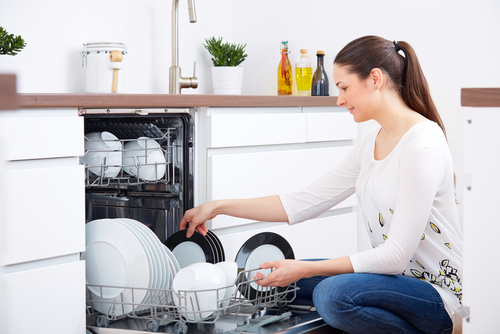How Much Water Does a Dishwasher Use
At the conclusion of nearly every meal, people have a choice to make: hand wash the plates and utensils or let the dishwasher do the work for them. Over the years the capabilities of the dishwasher as an appliance have grown drastically, however some individuals are still unsure of which method is more sensible to rely on. When considering energy use, make sure to ask yourself, “How much water does a dishwasher use in comparison to hand washing?” After your next meal, consider the following before going one way or the other.
Do Dishwashers Use More Water Than Hand Washing?
How A Dishwasher Works
To complete a load of dishes, the dishwasher must utilize a number of processes to ensure that the remnants of food get removed and that plates and utensils are thoroughly sanitized. When activated, it adds and heats water, applies detergent, utilizes jets to clean dishes, and finally removes the dirty water from the cleaning and ends with a rinse. To note, only a small portion of the bottom fills with water, rather than filling completely. It also keeps track of time so that it can properly move along through each phase.
On the operator side of things, there are some inputs required to clean dish ware such as supplying detergent and providing details about the wash. You can opt for a dry cycle but it is recommended to skip this step to save energy. As of 2017, the U.S. Energy Information Administration (EIA) found that dishwashers are one of the least-used appliances in homes with research showing that more households have microwaves and laundry machines.
What Does It Take to Run a Dishwasher?
The amount of water and energy utilized by dishwashers can vary based upon their overall efficiency. Energy Star is a program within the U.S. Environmental Protection Agency (EPA) that certifies certain appliances as energy-efficient. Thus, the average usage for dishwashers comes in the form of the standard versions of the appliance as well as the Energy Star certified ones.
So, how much water does a dishwasher use? While the average cycle uses around 6 gallons, energy-efficient washers can cut that in half to as few as 3 gallons. When it comes to the energy required, the process of relying on the appliance actually uses about half as much as it takes to wash dishes by hand. This, in large part, is due to the fact that newer dishwashers do not require the use of the hot water heater and instead can utilize internal heaters that do the same job for far less energy. In terms of kilowatt-hours needed, the energy needs per load can range from .90 kWh to 1.60 kWh.
Shortcomings of Hand Washing Your Dishes
Hand washing is a popular alternative which comes with its own set of benefits and shortcomings. First and foremost, it is helpful for cleaning a small number items. While the time saved may seem like a desirable plus, the reality is that in order to thoroughly sanitize dish ware, the temperature of the water needs to reach upwards of 140 degrees Fahrenheit. Because individuals cannot handle that kind of temperature, it is most practical to just rely on the dishwasher.
Beyond the heat required to properly clean plates by hand, the amount of energy and water that is wasted during hand washing is quite alarming. It is estimated that per load, individuals use around 27 gallons of water to clean by hand and on an annual basis, over 6000 gallons are wasted by hand washing per household. In the same wasteful manner, hand washing requires the use of the hot water heater to pump warm water to the sink. In doing this, a considerable amount of energy is used and meant to aid in dishwashing but far too often is lost as people leave the sink running. And in the event that the sink is plugged and the water is recycled, the use of water that becomes dirtied early on after use, once again undermining the sanitary element of the cleaning.
Develop Smart Habits: Improving Dishwasher Efficiency
Though it is the more efficient option, using the dishwasher can come with its own share of drawbacks such as energy use and cost. One of the easiest ways to improve efficiency is to make sure that it is only ran when there is a full load. This will help to minimize excessive use of detergent as well as water and energy. At the same time, having the appliance filled to the brim can reduce its cleaning effectiveness and hinder the hot water jets, so be mindful of that. For those with older appliances, making the switch to a newer energy-efficient one can promise reduced energy use.
One thing that can contribute to the cost of operating the dishwasher is the time of day in which it is done. During peak hours, or periods of high energy use, service providers face high demand from customers for power. In order to prevent being overwhelmed, companies will often incentivize customers through the use of off-peak hours in which rates are reduced during certain periods of time. If saving money and saving energy is a goal, consider checking if that is something provided by your energy company and take advantage of it.
The Verdict: Dishwashers Use Less Water Than Hand Washing
What our customers are saying
See why our power customers say we're the best electricity provider in Texas!
I was worried about getting electricity for my home through a prepaid company. I was calling around to see different rates then going through all the hassle of credit checks while dropping points each…
I have been with this company for several years and have been very happy since. Even when I moved, they made my usually stressful situation very easy and carefree. I recommend them to everyone that I…
I have enjoyed the service for 2 years now. In the beginning this service was planned to be temporary but with the service being so effective for me i decided to keep it for the long haul. I’m a happy customer.










